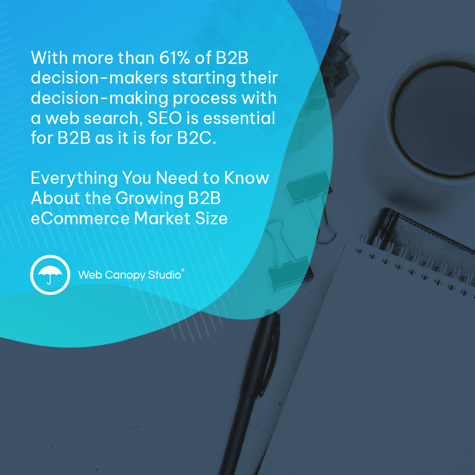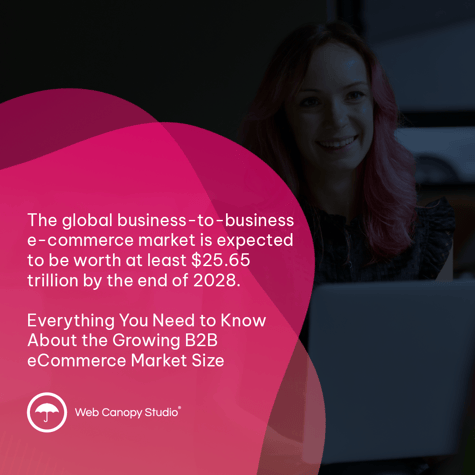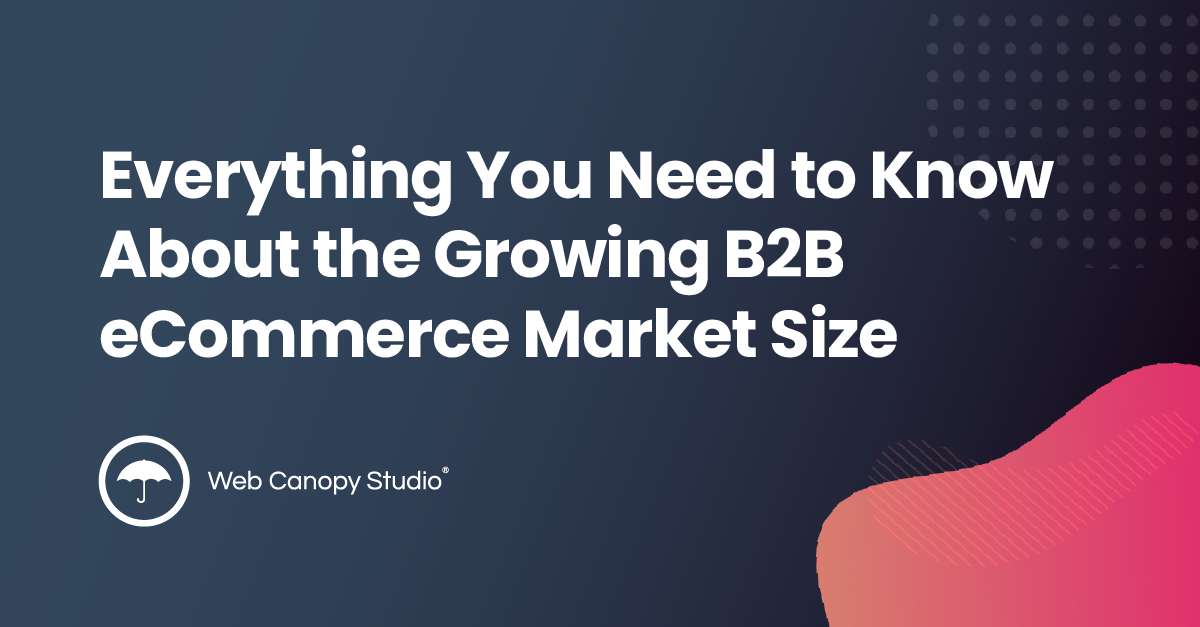The e-commerce market has grown through the years, and the B2B e-Commerce market is no exception. In fact, this industry is expected to surpass the B2C market in the next couple of years.
The global business-to-business e-commerce market size is expected to be worth at least $25.65 trillion by the end of 2028, rapidly expanding at a compound annual growth rate of 18.7% from 2021 to 2028. This growth can be attributed to how the pandemic affected customer behavior and the entire B2B business landscape.
During the first half of 2020, the pandemic impacted countless businesses worldwide. Some even had to temporarily suspend their operations in order to cope with the changes happening in the industry. However, the pandemic also brought change as more and more customers now prefer online shopping. This paved the way for the market growth of B2B e-commerce globally.
As the B2B e-commerce market started to cope and expand during the pandemic, several B2B companies focused more on digital transformation and meeting the demand of potential and existing customers by selling products and services using online platforms. In short, how B2B vendors adapt to the pandemic is one of the reasons why the B2B e-commerce market continued to thrive during 2020.
Most B2B companies operating from developed economies encourage customers to shop online. This was achieved by improving their online operations through a more seamless website design and easy payment options.
This article will provide in-depth information about the growth of the B2B e-commerce market and its growth drivers. Being equipped with this information will make it easier for you to steer your B2B company in the right direction, so you can benefit from the growth the market is experiencing and will experience in the future.

What Are the Key Factors Driving the Growth of the B2B eCommerce Market Size?
Now that we know that the B2B e-commerce market is growing and the trend is expected to continue, it's time to discuss its growth factors. This will help us understand the market dynamics of the B2B e-commerce market and how it achieved its current market size.
Mobile Traffic
The number of people using mobile devices in the B2B e-commerce market is growing rapidly, resulting in more frequent and larger online sales. There are several reasons behind this trend, but it's clear that B2B buyers will choose to use mobile channels as they're convenient and fast.
Eight out of ten B2B buyers use at least one mobile device for work and six out of ten state that their mobile use has a significant role in their recent purchase from a B2B company. B2B buyers also say that their work-related mobile use has increased through the years.
Reports from Google show that more than 50% of B2B online inquiries are made using a smartphone. The report also suggests that the number will continue to grow.
To make mobile an effective part of your B2B e-commerce strategy, you need to invest in design, technology, promotion, and staff training. The goal here is to provide a mobile experience that's superior and distinct from your competitors. This will require you to make mobile-friendly apps and websites with fast load times and display mobile-specific content, such as podcasts and videos.
Social Media
Social media is one of the most critical drivers of the growth of the B2B e-commerce market. According to a study, 84% of VP-level and C-level B2B buyers are influenced by the content they see on social media when considering a purchase from a B2B company.
The buying behavior in the B2B e-commerce market growth is gradually modeling the buying behavior common in the B2C industry. This is due to the convenience and availability of digital resources, the use of mobile devices, and the presence of digital natives — like Gen X and Gen Y — in buying teams. Social media has a massive impact on the competitive landscape of B2B e-commerce, with more than 90% of B2B buyers relying on social media to communicate with industry leaders and 72% using social media platforms to research solutions to common pain points.
Social media affects B2B buyers in a lot of ways. For example, B2B companies create profiles on different platforms, namely Instagram, LinkedIn, and Facebook, to share various content, communicate with new and loyal customers, and give prospects a better insight into the company's culture.
Having a strong online presence on social media enables B2B companies to create a sense of community around their specific target audience, product, and service. Therefore, it's not just the content that influences buyer decisions; it's also the interactions they have with the company on social media.
Implementing a robust social media strategy plays a vital role in the success of any B2B company, so make sure to have one set in place. To maximize social media, consider investing in paid ads, focusing more on content development, and optimizing your profile.
Search Engine Optimization
Search engine optimization, or SEO, is a vital part of any business's online strategy. With more than 61% of B2B decision-makers starting their decision-making process with a web search, SEO is essential for B2B as it is for B2C.
SEO is a digital marketing strategy used to help B2B websites rank higher in search engines like Google and Bing. Unlike SEO for B2C, SEO in the B2B industry tends to focus more on using keywords that decision-makers use when searching for products and services online. The pandemic that hit the competitive landscape of the B2B e-commerce market also made B2B companies realize that SEO is no longer an add-on — it's a must for success.
Even when marketing budgets were reduced across different industries due to the pandemic, B2B companies that invested in SEO early continued to thrive. In fact, B2B companies that had a clear SEO strategy in place saw increased growth and revenue. On the other side of the coin, B2B companies that solely relied on traditional ads suffered major losses in revenue and online traffic.
A sound SEO strategy begins by truly understanding your B2B buyers and the keywords they use when looking for your company online. Once you're equipped with this information, you can easily determine what keywords to include in your website and content. Using the right keywords and placing them in the right places online makes your website more visible, which can eventually increase your online traffic and conversion rates.
Personalized Shopping Experience
The top players in the B2B e-commerce market are Gen Y and Gen Z. Gen Y is the generation that was born between 1982 and 1994, while Gen Z are the people born between 1996 and the early-mid 200s. Together, they play one of the most important roles in the industry: decision-makers.
According to a study conducted by Google in 2015, 46% of B2B researchers were between the ages of 18 and 34. B2B researchers are essential in the buying process because their experience online can impact their decision to buy from a particular B2B company.
Millennials expect top-notch customer experience when engaging with a brand and making a purchase online. They will spend time and effort seeking information about a particular product or service. This means that eCommerce platforms should be easy to navigate and accessible on any device. They also want their online shopping experience to include efficient record-keeping, so they can track purchases and make informed decisions fast.
There are many ways to offer personalized shopping experiences online. For one, you can outsource professionals to create an app for your B2B company. This app should offer a convenient check-out process, easy navigation, and excellent customer service.
Faster, More Payment Options
The B2B e-commerce market has changed through the years, especially its payment options. A few years back, businesses had to pay for products and services using a credit card, check, or cash. Traditionally, credit cards offer several benefits that enable owners and managers to build a business's credit. However, this mode of payment can cost more to the buyer due to high-interest rates and fees. This is a common scenario when the buyer decides to purchase products or services abroad, as they have to pay for several fees such as foreign transaction fees. Most B2B customers would rather avoid paying such fees.
Because of the internet, the B2B e-commerce market now offers a wide variety of payment options to their customers. Aside from credit cards, bank transfers, and cash, B2B customers can pay through digital currencies, such as PayPal, Apple Wallet, or Venmo. As part of their additional service to users, PayPal even offers credit cards so businesses can take advantage of the policy. Digital currencies are also easy to use and ideal for B2B companies of different niches and sizes, lowering the barriers for newer or inexperienced entrepreneurs.
With the number of payment options you can offer to your B2B customers today, it's best to use one that's convenient to your target audience. You can expand by offering one or two additional payment options (on top of cash, check, or credit card) and then add more as you go along.

Data Analytics
The report forecasts revenue growth of the global big data analytics market is expected to reach at least $68 billion by the end of 2025. And while big data analytics is often utilized by the B2C market, B2B companies can get as much value from analyzing different types of data as their customer-facing counterparts. This is especially true when it comes to the B2B e-commerce market.
Big data analytics in the B2B e-commerce market provide B2B companies with in-depth information about their customers, company market share analysis, market data points, product inventory, and more. Data analytics is like a goldmine of information to B2B companies — it offers data that helps companies to determine which of their existing strategies are driving results and which ones require improvement.
In the B2B e-commerce market, data analytics means collecting data from customers, orders, transactions, sales processes, inventory management, and marketing campaigns. Moving all that data into one business analytics platform makes it easier for B2B companies to access information about their business. Most B2B companies invest in analytics tools that use AI, machine learning, and natural language processing to convert raw data into actionable insights. As a result, entrepreneurs can view this data in the form of charts, dashboards, graphs, and reports.
B2B companies that utilize data analytics for e-commerce have the opportunity to uncover vital information that drives business growth, enhances communication, improves engagement, and personalized customer experience. Analytics can also help B2B companies improve their account-based marketing initiatives.
You can find several data analytics tools in the market today. To ensure that you'll end up with one that'll drive long-term results to your B2B company, compare options. This means you have to look into different data analytics tools and assess which one gives you the data that your business needs.
Chatbots
How fast prospects receive answers to their query affects their buying decision. Regardless of how promising the products and services of a B2B company are, prospects will likely look for other brands if that company takes days or weeks to answer. Poor customer service is often associated with the quality of a company's offerings.
Because of their ability to answer queries within seconds, it's no surprise why chatbots have contributed to the growth of the B2B e-commerce market. Chatbots have become a holy grail for many B2B companies as they allow them to respond to clients instantly, interact with prospects and existing customers, and speed up the sales cycle. Chatbots also enable B2B companies to engage with several B2B buyers simultaneously.
Research shows that about 40% of online users prefer interacting with chatbots than a company's sales team. And with major industries, such as healthcare and beauty, turning into digital technology, the popularity of chatbots in the B2B e-commerce market is expected to increase moving forward.
According to a 2022 report on chatbot trends, 73% of customer queries can be addressed with less than five messages. Chatbots can ease the burden and free up support teams as customers can handle issues on their own. This allows the support team to take on bigger, more significant responsibilities in the company.
One of the best ways to maximize chatbots in your B2B business is to use the technology to collect customer data and user feedback. The data gathered by the chatbots can be extremely useful for understanding how your B2B customers see your company.
Improved UX/UI on Websites
B2B websites are expected to satisfy greater demands than B2C websites for many reasons. B2B buyers use websites to connect with different third parties, namely shippers, distributors, and vendors. They also use the internet to research products and check the availability of delivery before making bulk orders. But the needs of B2B buyers don't end there.
Because bulk orders involve hundreds or thousands of dollars, it's common for B2B buyers to use websites for many other purposes. They want the platform to give them access to real-time updates on their orders (whether it's already shipped or its estimated date of arrival), have the ability to customize orders, and many others. B2B buyers are also influenced by easy-to-use design features, like those they use when shopping for personal products and services.
What this means for B2B companies is that you have to create and offer well-designed and highly functional websites to your customers. That could mean having an intuitive website design that answers customers' questions even before they formulate them. Everything that a user does and sees on the website should provide the best experience using the right language, graphics, design, responsive screen displays, automation features, and navigation architecture.
Takeaway Points
All the information presented in this article shows how fast-paced the B2B e-commerce market is. If your business operates in this industry or you're planning to dive into the industry soon, it's crucial to embrace the newest key trends for your brand to be distinct from your competitors.
Regardless of how effective your products are or how helpful your services are, never be complacent. Your company ranking in the industry depends on how well you can adapt to industry trends and use these trends to improve your global business.



